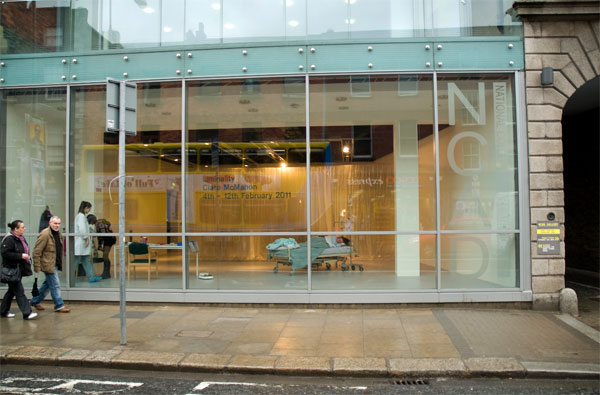
The book Rings of Saturn by German writer W.G. Sebald opens with the author describing a period of time he spent confined to a hospital bed in the aftermath of an epic walking journey across coastal East Anglia. “All that could be seen of the world from my bed was the colourless patch of sky framed in the window,” he says. It is a brief account of one very particular viewpoint, but in a certain respect it is also a broad and beautiful reflection upon tens of thousands of other viewpoints – those which are normally obscured by the daily bustle of life, but which take on a far greater significance once we are forced to be still and watchful for long enough to appreciate their subtleties.
This thought sprang back to mind when I found myself unexpectedly lying in a hospital bed – when I found myself unexpectedly noticing a tree-shaped pattern of raindrops against a windowpane and the tiny detail of blue zigzags stitched tight into a blanket drawn about my chin. But this was far removed from Sebald’s Norwich of the early nineteen-nineties – this was not even an actual hospital. Instead, the bed in question was positioned in the middle of a sparsely furnished gallery space, and the window stretched the length of an entire wall and bore the frosted letters N C A D in a vertical stack all down the glass.
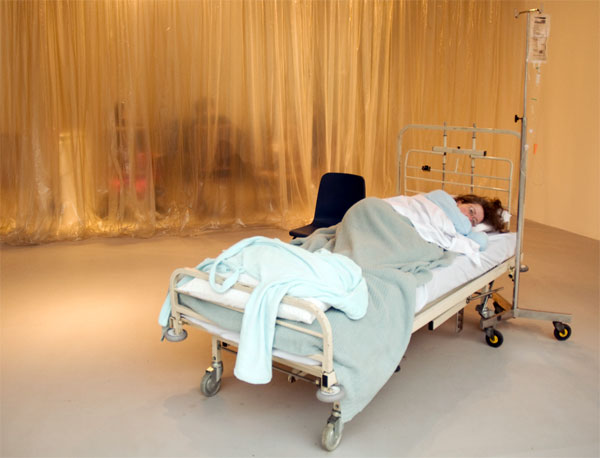
This was a project entitled Liminality and I was experiencing it exactly as its creator, Ciara McMahon, had intended it to be experienced. To the front of the gallery there was a reception desk manned by a white-coated attendant and to the back there was a curtain of polyester-style fabric. The desk was scattered with consent forms and medical implements. The curtain partitioned an arrangement of mismatched chairs which had been set up – not for the meeting of a support group of some kind, as they appeared to be – but to facilitate the exhibition’s programme of parallel ‘discursive events’.
The main curiosity was the hospital bed positioned in the centre of the floor and the outline of McMahon herself lumping the covers. Here she lay between the hours of 10am-5pm every day during the course of the show – her only relief provided by visitors, like me, who agreed to ‘donate’ their time to the project by taking her place for a minimum period of fifteen minutes. So long as they signed certain documents and fulfilled certain criteria, the willing participants would then be tucked into the strange warmth of McMahon’s residual body heat and encouraged to remain as motionless as possible, and to wait.
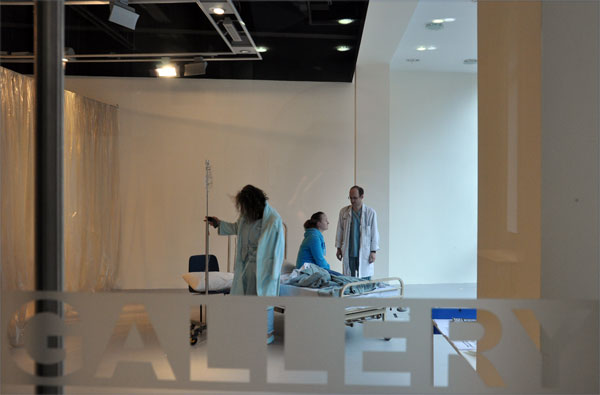
Ciara McMahon trained initially as a doctor and now works as a GP as well as, since studying for her Masters in NCAD last year, practicing fine art. In conversation with Fiona Loughman, Tina Kinsella and Dr.Sylvia Loeffler for a collateral event on the final day of the exhibition, McMahon says that most people she meets are confounded by the diversity of her background, whereas she considers the two fields to be closely connected. She expands on this by telling how the Liminality project only came about because her knowledge of organ donation in a strictly medical sense had sparked a desire to explore it philosophically – by means of the patient’s feelings and fears as opposed to an examination of their medical charts. It was because of this that she became involved with the Living Gift Transplant Support Group and it was through hosting a blog (The Leaky Self – http://livinggift.ie/leaky-self/) that she came into contact with a number of recipients who agreed to be interviewed and to collaborate on a short film entitled I used to think it was gold, but really it‘s a platinum one, Platinum, 2011.
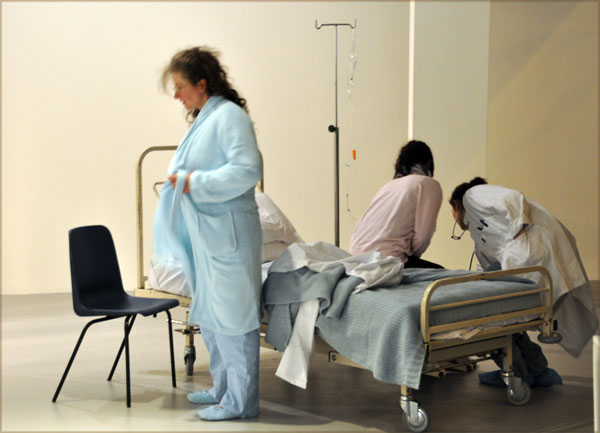
For the duration of my own ‘donation’, I had no way of knowing how many minutes had passed until the white-coated attendant came back to release me. This was definitely something which added to my appreciation of the ‘limbo state’, the ‘in-between land’ of what it is to be on the list for an organ transplant. Time passed terribly slowly and my thoughts seemed terribly loud – but otherwise it was hard to be absorbed enough to forget that this was not a real life-and-death situation, but merely an experiment soon to end. Instead, I stared out the window at the colourful activity of Thomas Street – at a Jack Russell terrier in a tartan dog-coat fastened to the furthest end of an extendable lead, at a lone mitten crumpled beside a yellow line on the road. And easily the most affecting part of my waiting experience came when an elderly woman passed by with two clear tubes extending from her nostrils – presumably for medical purposes. She was walking very slowly and uncertainly and did not look up and notice me. Yet still, lying there as a spectacle in a hospital bed, I felt suddenly so horribly embarrassed and ashamed – such an impostor and a fake.
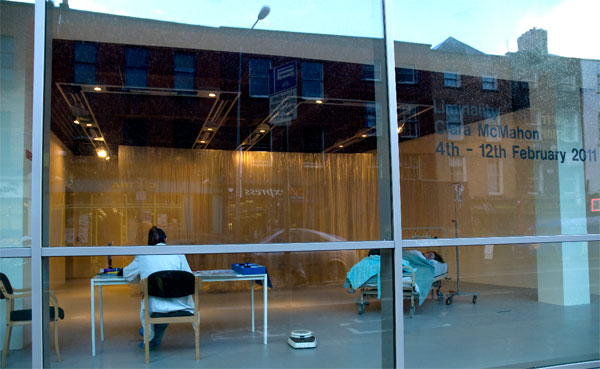
McMahon readily admitted, in conversation, that just like me she felt a ‘sham’ at many points throughout the hours of her week inside the sheets. When talking about Liminality she was, at times, refreshingly self-deprecating about the project as a whole – even going so far as to declare it “a failed reconstruction.” “I am not a transplant patient,” she said, “I am not sick, and as a result, this is a really flawed exercise.” Even though McMahon is considerably better qualified as a spokesperson for the transplant community than most, she was quick to emphasise that she would “squirm at the idea of giving anyone a voice.”
And it is not the only idea that McMahon noticeably squirmed at during the closing day‘s public conversation. You may or may not have noticed that – up to this point in my review – I have yet to use the word ‘art’ in reference to the project or the word ‘artist’ in reference to its creator. This is not so much my own choice of terms but is in response to McMahon’s own blunt refusal to say whether or not she considered Liminality ‘art’ or even wanted others to interpret it as such. When I suggested that the project looked a lot like ‘performance,’ she was quick to argue that this was not so, countering that there is a level of theatricality to the designation that undermined the authenticity of what she was attempting.
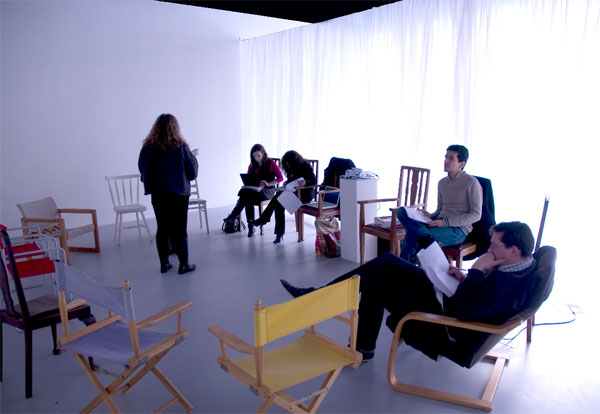
And on proper reflection, I am inclined to agree. I am inclined to believe that Liminality was never trying to be about any kind of big ethical issues or intellectual debates. Instead, it was always about the raindrops and the zigzags and the tartan dog-coat and the lone mitten – it was about stripping life back to a sparsely furnished space of pure feeling, a space where every subtlety is vital and every passing viewpoint asserts its quiet meaning. But perhaps my inclinations have a little bit of something to do with Sebald whispering in my ear… “I can remember precisely how,” he says, “upon being admitted to that room on the eighth floor, I became overwhelmed by the feeling that the Suffolk expanses I had walked the previous summer had now shrunk once and for all to a single, blind, insensate spot.”